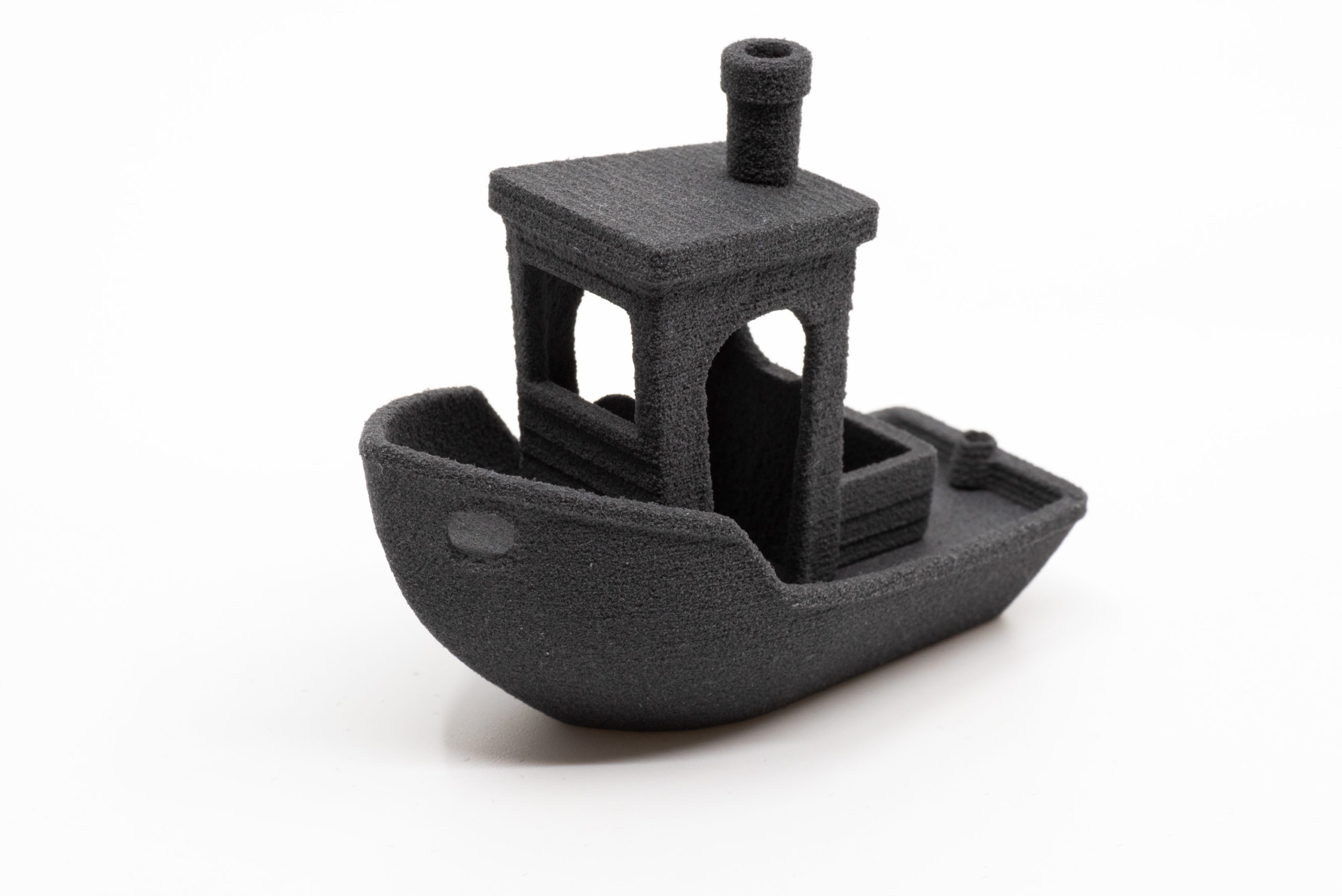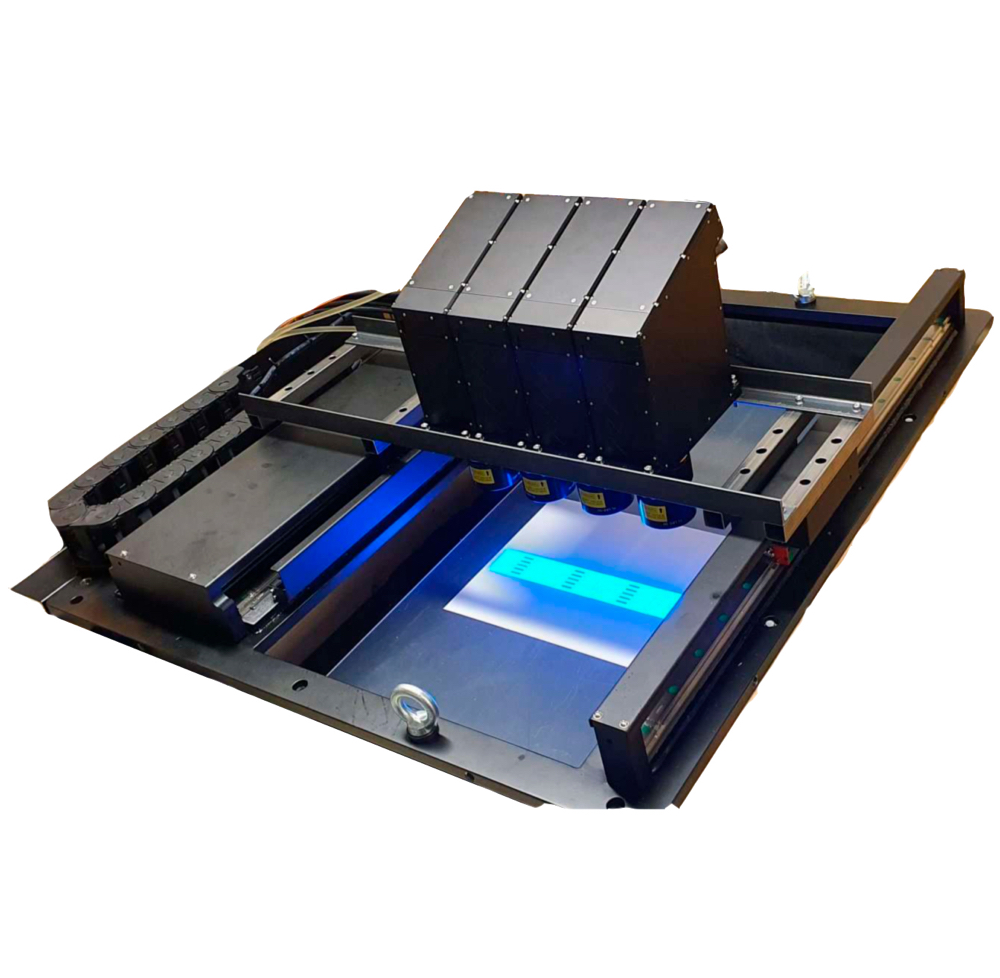In fall 2020, Visitech quietly made news with the release of a scrolling DLP projector capable of sintering plastic powder, potentially opening up new levels of throughput and reduced cost in the world of powder bed fusion (PBF). At the time, this was described as a near-infrared projector, but, now, the Norwegian firm has increased the powder. Visitech has announced it has 3D printed nylon powder with a new infrared (IR) PBF technology, dubbed direct image sintering (DIS).
The standard for PBF has long been selective laser sintering (SLS), in which a laser moves point-by-point across a powder bed, fusing plastic particles as it goes. While the technology is capable of higher resolution and larger batches than fused deposition modeling, it is slow and results in a surface finish that requires post-processing. Just as projector-based digital light processing (DLP) advanced upon laser-based stereolithography, DIS may bring the same benefits to PBF.

The world’s first Benji boat printed using IR for sintering powder bed fusion. The new AM method, dubbed DIS and developed by Visitech, has massive potential. Image courtesy of Visitech.
According to Visitech, DIS improves upon SLS with higher print speed, resolution, and build area. By fusing an entire layer at once, DIS exponentially increases the speed of SLS in the same way DLP did. However, this is further enhanced by the fact that Visitech has also developed a scrolling subsystem to stack multiple light engines and a motion stage to scroll projectors across a much larger build. This has potential for increasing throughput of both PBF and DLP 3D printers.
DIS is the result of significant research on the part of Visitech, a company with 20 years of experience building DLP subsystems. To create the technology, the company had to overcome key challenges related to power management and system cooling. To achieve full-layer image projection in a single shot, the R&D team had to find a light source sufficiently powerful for melting the powder with high precision. In turn, they designed an IR projector capable of generating a whopping 120W, necessary for competing with the performance of SLS lasers, though applied to an entire print area, rather than a single point.
This, however, resulted in a massive power load that caused excessive temperatures that could have damaged the light engine. The team then applied its expertise from having tackled LLS and LRS projectors to the DIS project, developing a powerful liquid cooling system that could manage the projector’s operating temperature and extend its lifetime.

The very first DIS concept test run produced the distinctive “V” in Visitech’s logo, but the technology is geared for high resolution, mass production capabilities soon. Image courtesy of Visitech.
Once this was accomplished and the proper parameters determined, the company went about demonstrating that this new 3D printing method could actually work. Visitech’s team was first excited with the sight of the initial layer hit with 120W of IR light, a feeling that was heightened by the final excavation of the print: a fused Visitech logo.
With the DIS technique validated, the company has moved forward toward commercialization of high-throughput AM.
Alfred Jacobsen, Managing Director of Visitech Engineering GmbH, the company’s German branch, noted: “As we have now proven that it works in our conceptual lab environment, our immediate next step is to tune the parameters further and perform in-depth research to confirm different material properties. Learning how various PB materials perform in this process is essential to our machine-building customers.”

VISITECH’s LRS-MCx Reference Motion stage can use up to four UV DLP projectors or two NIR projectors. Image courtesy of Visitech.
The company believes that it will be able to achieve laser-like resolution soon, necessary for the technique be competitive against SLS. Additionally, the company believes it will be able to expand beyond the nylon used for its test phase and eventually 3D print with PEEK, the toughest material in the 3D printing industry.
Next, Visitech intends to demonstrate the use of DIS with its novel scrolling concept. This will include mounting DIS projectors to a motion stage to 3D print across large build areas. Once this is achieved, the company believes it could completely change the industry.
“Visitech’s DIS technology aims to include the light source inside the DLP light engine, allowing it to achieve a similar price range as our DLP scrolling subsystems for UV-SLA,” Jacobsen told 3DPrint.com. “We see DIS as complementing the existing laser-based methods and providing another performance level to customers. Our DIS technology enables machines on a different scale, since the build area is in meters – while still keeping a very high resolution. Additionally, DIS allows for a much higher fill factor in the print patch, since the IR power is available across the complete layer simultaneously. In SLS systems, the laser addresses all points of the laser sequentially.”

Visitech successfully achieved polymer powder bed fusion using a powerful DLP-based IR light engine to project the powder-melting image in one shot – which is faster than traditional SLS methods. Image courtesy of Visitech.
DIS was the result of close collaboration with Visitech customers and suppliers, which led to deploying the knowledge gained from working with them to developing the concept. Director of R&D Endre Kirkhorn spoke to this strategy, saying, “This way, we gain a lot of valuable experience off-the-bat. For Visitech, that means building industrial projectors while tying in our existing technology for the infrastructure. That is our recipe.”
Kirkhorn believes that their IR engine will be ready for the market later this year, with the company ready to work with machine builders to integrate DIS into their new systems. Jacobsen told 3DPrint.com that some users have already gotten their hands on the technology, saying, “Some early adopters are already working with our demo systems for learning and prototyping purposes. Prediction for machine product introduction is hard to confirm at this stage, but we are optimistically expecting to see the first products in 2022.”
If the company remains on track with this development, it could quickly disrupt the PBF space, as HP intends to do with Multi Jet Fusion and Xaar and Stratasys intend to do with High Speed Sintering and Selective Absorption Fusion respectively. How DIS will compare with these processes is not yet known, but because Visitech will be supplying the motion stage and IR projectors, it’s possible that DIS will proliferate more quickly to a greater number of machine builders, thus opening up the technology to a broader number of applications. We’ll just have to wait and see until it officially hits the market.
Subscribe to Our Email Newsletter
Stay up-to-date on all the latest news from the 3D printing industry and receive information and offers from third party vendors.
You May Also Like
Further Understanding of 3D Printing Design at ADDITIV Design World
ADDITIV is back once again! This time, the virtual platform for additive manufacturing will be holding the first-ever edition of ADDITIV Design World on May 23rd from 9:00 AM –...
3D Printer Maker EVO-tech Reborn as NEVO3D — Once More With Feeling
EVO-tech was a 3D printing service and original equipment manufacturer established in 2013 and based in Schörfling am Attersee, Austria. The company produced high-quality material extrusion systems featuring linear bearings,...
3D Systems Brings 3D Printed PEEK Cranial Implant to the U.S. with FDA Clearance
For more than 10 years, 3D Systems (NYSE:DDD) has worked hand-in-hand with surgeons to plan over 150,000 patient-specific cases, and develop more than two million instruments and implants from its...
CDFAM Returns to Berlin for Second Annual Symposium
The second CDFAM Computational Design Symposium is scheduled for May 7-8, 2024, in Berlin, and will convene leading experts in computational design across all scales. Building upon the first event...































